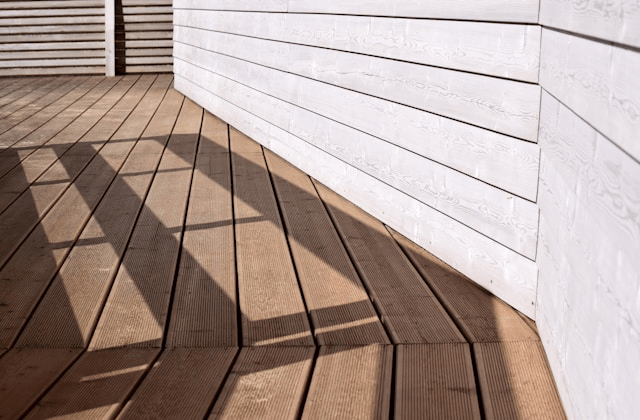A wooden deck is a beautiful extension of your home, offering the perfect place to relax, entertain, and enjoy the outdoors. But without proper maintenance, even the sturdiest deck can become weathered, cracked, and discolored over time. The key to preserving its appearance and structure is knowing how to stain a deck and seal it correctly.
In this comprehensive guide, we’ll walk you through how to stain and seal a wooden deck from choosing the right materials to avoiding common mistakes so your outdoor space stays looking its best year after year.
Why Staining and Sealing Your Deck Matters
Wood is naturally vulnerable to the elements. Rain, sun, snow, and temperature changes can cause it to warp, crack, or rot. That’s where staining and sealing come in.
Benefits of Staining and Sealing:
-
Protects against moisture damage and wood rot
-
Prevents fading and sun damage
-
Enhances natural wood grain and color
-
Extends the overall lifespan of your deck
-
Improves curb appeal and home value
A properly stained and sealed deck not only looks great but also withstands seasonal wear and tear far better than an untreated surface.
When and How Often to Stain and Seal
Timing is everything when it comes to deck maintenance. Whether your deck is brand new or several years old, it’s important to stain and seal it under the right conditions.
Ideal Conditions:
-
Dry weather with temperatures between 50–80°F
-
No rain in the forecast for at least 24–48 hours
-
Low humidity for optimal drying
How Often Should You Stain and Seal?
-
Typically every 2–3 years, depending on weather exposure and traffic
-
If water no longer beads on the surface, it’s time to reseal
-
Gray, faded, or splintering wood are signs that staining is overdue
Staying on top of this routine is one of the most effective ways to protect outdoor wood.
Materials and Tools You’ll Need
Before starting your deck staining project, gather all necessary materials and tools. Having everything ready will make the process smoother and more efficient.
Basic Tools and Supplies:
-
Broom or leaf blower
-
Deck cleaner or wood brightener
-
Garden hose or pressure washer
-
Scrub brush or stiff-bristled broom
-
Sandpaper or power sander (if needed)
-
Paintbrush, roller, or pump sprayer
-
Drop cloths or painter’s tape
Choosing the Right Stain:
-
Transparent: Shows natural grain, minimal color, lightest protection
-
Semi-transparent: Adds color while showing some grain
-
Solid stain: Most pigment and coverage, hides flaws
Choosing the Right Sealant:
-
Oil-based sealers: Deeper penetration, better moisture protection
-
Water-based sealers: Faster drying, low odor, easier cleanup
For some products, stain and sealant are combined. If using separate products, apply stain first, then sealant after it dries.
How to Stain and Seal a Wooden Deck
Ready to refresh your deck? Follow these clear steps to ensure lasting results.
1. Clean the Deck Thoroughly
Start by removing dirt, mildew, and old stain or sealant. Use a deck cleaner or a mix of mild detergent and water. For tough stains or mold, a specialized wood brightener can help restore the surface.
-
Sweep off all debris
-
Wet the deck with a hose
-
Scrub with a stiff brush or use a pressure washer (on low setting)
-
Rinse thoroughly and let dry completely at least 24–48 hours
2. Sand the Surface (If Needed)
If your deck feels rough, has peeling stain, or was pressure washed, light sanding will help the new stain adhere better.
-
Use 60–80 grit sandpaper
-
Focus on splintered areas or high-traffic zones
-
Remove all sanding dust before staining
3. Apply the Stain
Now comes the transformation.
-
Stir the stain thoroughly (don’t shake it creates bubbles)
-
Use a brush for edges and detailed areas
-
Apply with a roller or sprayer for even coverage
-
Work in small sections and follow the direction of the wood grain
-
Wipe off excess stain to avoid blotching or pooling
Let the stain dry according to the manufacturer’s instructions. Depending on the product, you may need a second coat.
4. Apply the Sealant (If Separate)
Once the stain is dry (usually 24–48 hours), apply the sealant to protect against moisture and UV damage.
-
Use a clean brush, roller, or sprayer
-
Apply evenly without over-saturating
-
Allow proper drying time before using the deck
Using a quality sealant can significantly enhance the durability of the finish and reduce future maintenance.
Common Mistakes to Avoid
Even seasoned DIYers can run into trouble. Here are the most common mistakes when learning how to stain and seal a wooden deck:
-
Staining in direct sunlight or extreme heat: This causes the stain to dry too fast, leading to uneven coloring.
-
Not allowing the deck to dry completely after cleaning: Moisture trapped under stain or sealant can lead to peeling.
-
Skipping prep work: Old finishes, dirt, or mildew can prevent the new stain from bonding.
-
Overapplying product: Too much stain or sealer can create a sticky, blotchy mess.
Take your time with each step and follow product guidelines closely.
Maintenance Tips for a Long-Lasting Finish
After your deck is stained and sealed, a little maintenance goes a long way.
-
Sweep regularly to remove dirt and debris
-
Clean spills immediately to prevent staining
-
Reapply sealant as soon as water no longer beads on the surface
-
Inspect annually for signs of wear, mildew, or damage
-
Cover during winter or harsh weather to minimize exposure
Following a deck maintenance guide helps preserve the work you put in and keeps your outdoor space looking great year-round.
Conclusion
Staining and sealing a wooden deck may seem like a big task, but with the right preparation, tools, and technique, it’s a rewarding project that enhances both the beauty and lifespan of your outdoor space. Knowing how to stain a deck properly not only protects your investment but also allows you to enjoy a cleaner, safer, and more attractive environment for years to come.









